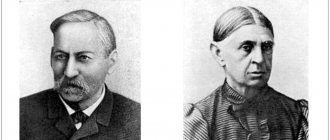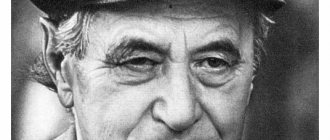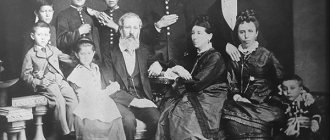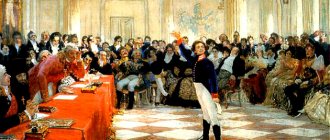Childhood and youth of I.A. Bunina
Born on October 10 (22), 1870 in Voronezh into an old, impoverished noble family.
“This family,” Bunin wrote in his “Autobiographical Note” (1915), “produced a remarkable woman of the beginning of the last century, the poetess A.P. Bunin, and the poet V.A. Zhukovsky (illegal son of A.I. Bunin). The father of the future writer, an extravagant landowner of the Oryol and Tula provinces, who went bankrupt due to his addiction to wine and cards, in his youth participated in the Crimean War of 1853–1856 and there he met with L. Tolstoy. The mother, deeply religious and possessing a sad, poetic soul, came, according to family legends, from a princely family. When Bunin was barely three years old, the family was forced to move from Voronezh to Yeletsky district. Among the first childhood impressions are the stories of the mother, the servants, the wanderers, the elements of folklore fairy tales, songs and legends, the living flesh of the original Russian speech, the blood connection with nature and the Central Russian landscape and, finally, the most poignant thing - the death of the younger sister, which punched a hitherto unconscious hole in a clear and unclouded perception of the wider life around. From these impressions all the main themes of future creativity grow.
In 1881 Bunin entered the first grade of the Yelets gymnasium. He was expelled in 1886 for failure to appear from vacation. His further fate was largely marked by two important circumstances: being a nobleman, he did not even receive a high school education, and after leaving his parents’ shelter he never had his own home and spent his entire life in hotels, other people’s houses and rented apartments.
Years of life in Yelets are spent wandering around the corners of a semi-impoverished nobleman, confident in his exclusivity. But it is to Yelets that Bunin’s future prose owes its knowledge of bourgeois life, the oppressive, but also peculiar poetry of the Russian outback.
Bunin keeps diaries where he records his observations. For Bunin it is an impression. The writer tries to capture everything that creates the image (shape, color, smell, size). For Bunin, it is very important to find the exact single word that conveys this color, this shape, etc. He did not tolerate approximation.
Bunin's poetry is precise, serious, and was awarded the Pushkin Prize.
Rice. 1. Portrait of young Bunin ()
His elder brother Yuli, a populist publicist, had a special influence on the development of Bunin’s personality. Under his leadership, Bunin studied the gymnasium curriculum. In 1889 he moved to his brother in Kharkov and found himself in a populist environment, which he later sarcastically described in the novel “The Life of Arsenyev” (1927–1933). In the same year, Bunin accepted an offer to join the Orlovsky Vestnik newspaper and met the proofreader Varvara Pashchenko at the editorial office.
He began writing his first poems when he was 7–8 years old, imitating Pushkin and Lermontov. Bunin the poet's printed debut took place in 1887, when the capital's newspaper Rodina published his poem “Over the Grave of Nadson.” In 1891, the first book of poetry was published: Poems 1887–1891 - rather weak, the writer subsequently disowned it. “Nadsonian” themes and intonations reign there: “civil grief”, lamentations of a “poet exhausted by the hardships” about a bogging down life “without struggle and labor”. However, already in these verses “Nadsonov’s” is adjacent to something else – “Fetov’s”, with the glorification of the “pure beauty” of the spiritualized landscape.
Rice. 2. I.A. Bunin .1893 ()
Bunin’s prose was connected with Tolstoy’s heritage by the question of the kinship of man with nature, the attraction to the eternal mysteries of existence, to man in the face of death, interest in the ancient East and its philosophy, pictures of passions, bright sensual elements and the plasticity of verbal depiction. From Chekhov, Bunin's prose inherited laconic writing, the ability to distinguish between the dramatic in the small and the everyday, the maximum semantic richness of an apparently insignificant figurative detail, which can become a hint not only of the character, but also of the fate of the hero.
Entering the literary environment
In 1895, in St. Petersburg, and then in Moscow, Bunin entered the literary environment, met Chekhov, N.K. Mikhailovsky, becomes close to V.Ya. Bryusov, K.D. Balmont, F. Sologub. In 1901 he published a collection of lyrics “Falling Leaves” in the symbolist publishing house “Scorpion”, but this was the end of the writer’s closeness to modernist circles. Subsequently, Bunin's judgments about modernism were invariably harsh. The writer recognizes himself as the last classic, defending the legacy of great literature in the face of the “barbaric” temptations of the “Silver Age”.
In 1913, at the anniversary of the newspaper “Russian Vedomosti”, Bunin said: “We have experienced decadence, and symbolism, and naturalism, and theomachism, and myth-making, and some kind of mystical anarchism, and Dionysus, and Apollo, and “flights into eternity,” and sadism, and acceptance of the world, and rejection of the world, and acmeism... Isn’t this Walpurgis Night!”
Rice. 3. I.A. Bunin. Start. 1900s ()
In 1893-1894, Bunin was strongly influenced by the moral and religious works of L.N. Tolstoy. He visited the Tolstoyan colonies in Postavy and seriously thought about simplification. But at the beginning of 1894, a meeting between Bunin and L.N. took place in Moscow. Tolstoy, which the young writer had long dreamed of. And Tolstoy convinced him to abandon simplification. For Bunin, Lev Nikolayevich remained throughout his life the highest embodiment of artistic power and moral dignity; the book “The Liberation of Tolstoy,” published in Paris in 1937, is dedicated to him. In an interview with the newspaper “Voice of Moscow” in 1912, I. Bunin spoke about the evolution of his ideological and political views: “I went through populism for a short time, then Tolstoyanism, now I gravitate most toward the Social Democrats, although I eschew any party affiliation.”
Rice. 4. L.N. Tolstoy and I.A. Bunin (Source)
My Bunin. Lyrical essay
I.V. Shumakova, Kursk
My discovery of I.A. Bunin
(lyrical essay)
It so happened that I only got to know the work of Ivan Alekseevich Bunin during my student years. I remember how, at a lecture on Russian literature of the twentieth century, our teacher said: “Ivan Alekseevich Bunin!” And then he solemnly added: “Our first Nobel laureate!” For some reason I really wanted to get acquainted with the writer’s works. Unfortunately, I had never heard Bunin’s name before, nor had I read his books. And not because of its denseness, it was just the time: they didn’t study Bunin at school, and there were no books by the writer at home. The institute library gave a collection of stories by Ivan Alekseevich with an unusual title: “Dark Alleys.” It was he who laid the foundation for my acquaintance with an amazing writer, unlike anyone else...
“Dark Alleys”... This book, it seems to me, can rightfully be called an “encyclopedia” of love dramas. The writer himself admitted after its publication: “She talks about the tragic and many tender and beautiful things, ─ I think that this is the best and most original thing I have written in my life.” These are indeed fair lines. Although in many of Bunin’s stories, love, which the writer told us about with such touching sincerity, is undoubtedly extraordinarily tragic, he rightly asserts that all love is a benefit for a person and the realest happiness. And it doesn’t matter that it sometimes ends in separation, the death of a loved one, or some kind of tragedy. Happiness is that there was love in life, that it touched you with its bright wing.
Bunin often depicted in his stories, in my opinion, by no means platonic love. For him it is sensual, visible, tangible, sometimes even romantic. And like any romantic, the writer wanted to create these unforgettable images-associations of love: its “dark alleys”... In fact, the heart skips a beat when you read about love in its different states, where, for example, it barely ignites, but will never come true ( “In Paris”), where the unrecognized (“Tanya”) languishes, where it turns into incredible passion (“Overnight”), where it captures all the emotional and spiritual thoughts of a person (“Natalie”). Unfortunately, in many stories it is clear that this a bright feeling cannot last forever, so the heroes simply need to part. Most often forever... If this does not happen, then fate itself may simply intervene in their life. Therefore, apparently, this is what happens: in the ending of many of Bunin’s stories, as a rule, one of the lovers dies. For Ivan Alekseevich, this is quite natural, because the heroes pay so dearly for their “little” happiness. And this is the tragic note of the sadly real symphony called love.
Love (according to Bunin) is one of the highest forms of human existence on Earth. This is such a tension in human matter when the thread of life is stretched to the limit, to the highest point of tension. Then it may not hold up and break. That is why his works often have a tragic ending. In Natalie, the main character dies during premature birth. The heroes in the stories “Galya Ganskaya”, “Zoyka and Valeria” end their lives tragically, seeing no other outcome; on the third day of Easter, the hero of the story “In Paris” dies in a subway car. Sometimes it even begins to seem that people come into this world each for their own piece of tragic love. But why does love suddenly have to be like this? I thought about this when I read Bunin. About this and much more. Yes, the book did not leave me indifferent. By the way. To the images. To the author.
And yet the enormous and gradually growing impression from the collection is a feeling of incredible happiness and, to a certain extent, joy from the knowledge that you invariably personify many of the main characters with the author himself. For some reason, you feel his kinship with them, and also with nature described in the stories, with the time depicted in them, with the memory of the heart that captured this or that love story. It turns out that this feeling
in the author’s understanding, it is eternal, just as nature itself, which gave birth to man, is eternal.
I also noted for myself that in Bunin’s stories I see that very often there is a clash between the author’s two positions. In one, he argues that love, like everything else on this planet, passes. It even seems to me that I can clearly hear his soothing whisper: “Everything passes ─ and this will pass...”. In another, he seems to convincingly prove that love ─ the brightest and greatest feeling ─ remains in a person’s soul forever. These two positions, these two voices are especially distinguishable, it seems to me, in the title story of the “Dark Alleys” series. In this work of amazing beauty and vitality.
As the writer himself later said, the impetus for the creation of the story “Dark Alleys” was a direct association of poetic lines from the magnificent poem “An Ordinary Tale” by Nikolai Ogarev (1813─1877), written by him in 1842. Bunin recalled: “I re-read Ogarev’s poems and settled on a famous poem... Then for some reason I imagined how my story begins: autumn, bad weather, a high road, a tarantass, with an old military man in it... The rest all somehow came together, was invented very easy, unexpected,─ like most of my stories.” So these lines, which gave the name to the cycle, are recalled in the finale by the hero of the story, Nikolai Alekseevich: “The scarlet rose hips were blooming all around, there were dark linden alleys...”.
In Ivan Alekseevich Bunin’s story “Dark Alleys,” we see a chance meeting of two people who once loved, more than 30 years ago: the current old officer and the successful owner of an inn. Then, in his youth, it was a young master and his peasant woman. But many years passed, and this meeting, which so reverently awakened the woman’s memory of her drama, showed how abandoned, not forgiving, betrayal by a man, she continued to love only him all her life. And the man, who once “heartlessly” abandoned her, now unexpectedly admitted to himself that he apparently “passed by” hot and bright love, thus losing “the most precious thing he had in life.” This meeting became a sign of fate for both of them. This is a meeting-repentance, a meeting-confession. And the story, according to the writer’s plan, turned out to be about the sad regret of irretrievably lost happiness...
Reading “Dark Alleys”, more and more often you are imbued with a feeling of extraordinary delight and happiness: Bunin the stylist is so perfect. Expressiveness, originality, subtle psychologism, an amazing form of narration ─ all this suggests that we have before us an extraordinary writer. The forms of narration vary amazingly: it can be a story from the perspective of the main character (the story “Natalie”), (“Clean Monday”), from the perspective of a young woman (“Cold Autumn”) or from the perspective of the author-narrator (“Overnight”) .
The cycle “Dark Alleys” represents a remarkable artistic wealth in terms of genre forms. These are drama stories (“Zoika and Valeria”, “Rusya”, “Galya Ganskaya”), sketch stories, fragments (“Smaragd”, “Chapel”), a legend story (“Ballad”), a parable (“Youth and old age"), a tragedy story ("Cold Autumn"). All this confirms the idea that while working on the cycle, the author honed his skills, as if he knew in advance that fate would have in store for him a long life in literature, a Nobel Prize and subsequently well-deserved happy recognition in his homeland, in Russia.
The story “Clean Monday” surprisingly fits into the fabric of “Dark Alleys.” It was written in Paris in 1938, where it was published in 1946. This work is also about love. About difficult love. I would even say that it is about a slightly strange love, which the main character ultimately refuses.
The story is told from the perspective of a hero whose name is not mentioned. But you feel with your whole being: the hero and the author are one person. In the story, our hero is simply “He”, and his beloved is “She”. Probably, such anonymity is created by Bunin in order to show the unusualness of the life situation in which our hero-narrator finds himself. Or maybe this is a tribute to tradition? Indeed, in other, if not many, stories by Ivan Alekseevich, the failure to give the name of this or that hero speaks of the atypicality of what is happening, thereby emphasizing its uniqueness. And also, it seems to me, it can serve as a sign of a generalizing, universal meaning.
Bunin in “Clean Monday” with emotional trepidation tells not only the story of unusual love, but also the mystery of human destiny. About the immeasurable happiness of loving and being loved. About the complex nature of human character. About the mysterious Russian soul, about our national character. And, of course, about the peculiarities of Russian people’s faith in God and about the sacraments and incomprehensibility of everyone on the path to Him. A piercing, surprisingly heartfelt and heart-tugging story. To some extent, even a little like a confession... Many years have passed, but in the heart of our hero the unquenchable fire of love still continues to burn, because only one woman rules there, there is simply no place for another.
The story “Natalie,” written by Bunin in 1941, is also about love. Everything is here: the amazing plot, the magnificent language of the work, and the characters, somewhat reminiscent of Chekhov or Turgenev, or maybe the heroes of Tolstoy or Kuprin, and the writer’s style, and the very form of the narrative ─ everything speaks of the enormous power of talent and the skill of Bunin -realist.
The plot is based on a love story. The kind of love that only happens once in a thousand years. The heroine is a typical “Turgenev girl” with an original, French-style name. The hero is a noble son who dreams of something other than platonic love. But when he met “his” Natalie on the path of life, he immediately fell passionately in love with her. He dreamed about her and, in all likelihood, remained faithful to her for the rest of his life, even after the woman’s death during childbirth. Isn't there something symbolic in this story? Probably in how men know how to love. In how they know how to remain faithful to the only woman they love all their lives. And it's amazing!
I believe that the writer’s wonderfully perceived story “Cold Autumn” is also marked by a special tragedy of love. It was written at the height of the Second World War - in 1944, when bloody battles with the Nazis were taking place in the writer’s homeland. Apparently, incredible pain and melancholy were in Bunin’s heart when he created his masterpiece. Lyrical miniature ─ this is how I would characterize the genre of the work. Love and fidelity─ this is what one could say about his idea. The plot is surprisingly simple. The girl and the boy have been friends for a long time and love each other, they are going to get married and are even already engaged. In an unexpected way, fate prepares a test for them: war is declared. Like a real man and officer, he goes to war. But fate once again gives him a chance: he returns to his beloved’s estate for one day only to say goodbye to her. Just for one day. The wedding has been postponed for several months: many people think that the war will end soon... The young people still have a whole life ahead and this is the only one
cold autumn evening. Words of love and fidelity, words of recognition are heard... And all this against the backdrop of the beginning of cold autumn. The girl’s words are like an oath: “I will not survive your death!”, and literally a moment later his answer: “... if they kill you, I will wait for you there. Live, enjoy the world, then come to me.” And a month later - the news of his death in the war... And for many years, yearning and mourning, having distorted her fate, she still remains faithful to his memory. How many examples like this are there in the history of world literature? Examples of fidelity to the feeling of pristine, shared and truly unquenchable love! Love, which is the fundamental principle of human life.
Reading the collection of stories by I.A. Bunin “Dark Alleys” for the first time, for some reason I immediately decided for myself: this is “my” writer. And then I tried to “draw” his portrait. He turned out to be an intelligent, smart, slightly mocking, of course, in love, but at the same time for some reason such a lonely and suffering person. After all, enormous nostalgia wafted from the pages of the book. A book created far from the Motherland, and therefore filled with incredible universal longing and pain for it.
“Dark Alleys” began my acquaintance with the work of the writer, whom I now love very much, re-read often and never cease to admire the power of his talent. And now I’m telling my students about “my” Bunin. About a man “struck” by love, loving and loved, joyfully contemplating everything around him and at the same time yearning for Russia to the point of heartache... Yes, probably only here in Russia could an extraordinary writer be born, whose work combined the subtle skill and realism of Russian classical prose.
Brief summary of the article “My Bunin”
My acquaintance with I.A. Bunin began in my distant student years with the collection “Dark Alleys” - an “encyclopedia” of love dramas. In many of these stories, love is tragic. But the happiness and joy from the knowledge that she is eternal, like nature and man, does not leave you. You admire the writer’s style: the expressiveness of the language, the originality of the images, the subtle psychologism and manner of narration. The stories are also remarkable in their genre forms. Bunin is “my” writer: he has “strict craftsmanship” and the ability to “develop the traditions of Russian classical prose.”
Application for participation
About the author
- Last name, first name, patronymic: Shumakova Irina Viktorovna.
- Higher education.
- Place of work: Municipal educational institution “Secondary school No. 59” in the city of Kursk.
- Position: teacher of Russian language and literature.
- Academic degree: I don’t have one.
- Academic title: I don’t have one.
- Contact numbers: (4712)
50-90-86 (home), - 8-903-876-37-15 cell.
- My email address:
irveek @ mail . ru - Home address: Russian Federation, 305003, Kursk-3, 1st Suvorovsky Lane, building No. 64/10.
- Title of the article: “My Bunin.”
- The form of participation is full-time.
- Interest in publication – publication is needed.
Bunin's creativity
The 1890s–1900s were a time of hard work and rapid growth in Bunin’s popularity. The book “To the End of the World and Other Stories” (1897) and the poetry collection “Under the Open Air” (1898) were published. Having independently learned English, Bunin translated and published in 1896 the poem by the American writer G. Longfellow “ The Song of Hiawatha.” This work was immediately rated as one of the best in the Russian translation tradition, and for it in 1903 the Russian Academy of Sciences awarded Bunin the Pushkin Prize. And already in 1902–1909, the publishing house “Znanie” published his first collected works in 5 volumes.
Rice. 5. I.A. and V.N. Bunins ()
In November 1906 Bunin met V.N. Muromtseva (1881–1961), who became his wife, his closest person, and after her husband’s death, his biographer, publisher and commentator. In the spring of 1907, Bunin and his wife set off on their first “cherished journey” - to Egypt, Syria, Palestine, seeking to find “liberation from time, from earthly corruption... in these lost kingdoms of the East and South, in the region of dead, forgotten countries, their ruins and necropolises " (Records 1907). Impressions from travels over the years were compiled into the book “Shadow of a Bird” (Paris, 1931).
By this time, in the minds of readers and critics, Bunin is one of the first writers of Russia. In 1909 he was awarded the second Pushkin Prize and was elected honorary academician of the Russian Academy of Sciences.
Although its popularity among the mass reader of the early 20th century. could not compete with the fame of L. Andreev or M. Gorky, in the first half of the 1910s, Bunin gained a reputation among the literary elite as perhaps the leading modern prose writer: in 1910 the story “The Village” was published,
in 1912 - the collection “Sukhodol”: stories and stories 1911–1912,
in 1913 - the book “John the Sower”: stories and poems 1912–1913,
in 1916 - “Mr. from San Francisco”: works 1915–1916.
These books are absolute masterpieces of Bunin's pre-revolutionary prose. And already in 1915 the publishing house A.F. Marx published the second collected works of the writer - in 6 volumes.
The themes of Bunin's works are themes of time, memory and oblivion, space.
All the characters are trying to understand life, there is a high melancholy that does not allow them to get lost. They understand that everything needs to be understood.
Critics reproach Bunin for writing about nothing, there is no idea of a story, what are all these observations for. The writer closest to Bunin at the moment is Chekhov.
Major works
In order to appreciate the work of Ivan Bunin, we recommend that you familiarize yourself with his most famous works:
- "Antonov apples" A lyrical story, which is built in the form of a monologue with memories. In it, the author, and the whole country along with him, says goodbye to the forever lost world of the nobility, ruined estates and estates.
- "Mr. from San Francisco." The story is about a rich man who was convinced that with money he could buy anything. However, all his fortune was powerless when death itself came for the master. The main moral of the story is that the main values in life are not material things. The main moral of the story is that the main values in life are not material things.
- "Dark alleys". This work is a collection of individual episodes, short stories and short novels. They are all united by one theme - love and the versatility of this feeling. Here the author calls the incomprehensible wilds of the human soul “dark alleys.”
- "Mitya's love." A story whose main theme is also love. Readers can see two extremes of this feeling: how it can become a source of happiness and inspiration, and how it can lead to real tragedy. The main characters are still very young, which is why they are so overcome by passion and intense emotions.
- "The Life of Arsenyev." A novel that I. A. Bunin himself called nothing less than an autobiography. The plot revolves around the life of a fictional character, but it contains many events and impressions that the author himself encountered.
The biography of Ivan Bunin is proof of how a person can achieve great success even without good input if he works hard. Being a child from a poor family who did not even complete his school education, Ivan Alekseevich was able to become a Nobel Prize laureate. And even after he was forced to leave Russia forever, he continued to create, so now his works are perceived as nothing less than Russian classics.
Bunin and events in Russia
The First World War was perceived by Bunin as the greatest shock and an omen of the collapse of Russia. He met both the February Revolution and the October Revolution with sharp hostility, capturing his impressions of these events in the diary-pamphlet “Cursed Days” (published in 1935, Berlin). The writer ponders here the national origins of the Russian catastrophe, glares at the Bolsheviks - the “demons” of the 20th century, with the fury of a man who most of all despises any falsehood and pose, rejects the intelligentsia’s “literary” perception of what is happening: “Now the reality generated by the primordial Rus''s thirst for formlessness (hereinafter cited in Bunin's italics) ... I just try to be horrified, but I really can’t. Real sensitivity is still lacking. This is the whole hellish secret of the Bolsheviks - to kill receptivity... Yes, we think and philosophize over everything, even over the unspeakable things that are happening now...”
The main characters and their characteristics
The image of the main character can be viewed from several angles of the narrator: a young man in love evaluates his chosen one as a participant in the events, and he also sees her in the role of a person who only remembers the past. His views on life after falling in love, after passion, change. By the end of the story, the reader now sees his maturity and depth of thoughts, but at the beginning the hero was blinded by his passion and did not see the character of his beloved behind it, did not feel her soul. This is the reason for his loss and the despair into which he plunged after the disappearance of the lady of his heart.
The girl's name cannot be found in the work. For the storyteller, this is simply the same one - unique. The heroine is an ambiguous nature. She has education, sophistication, intelligence, but at the same time she is withdrawn from the world. She is attracted by an unattainable ideal, to which she can only strive within the walls of the monastery. But at the same time, she fell in love with a man and cannot just leave him. The contrast of feelings leads to an internal conflict, which we can glimpse in her tense silence, in her desire for quiet and secluded corners, for reflection and solitude. The girl still cannot understand what she needs. She is seduced by a luxurious life, but at the same time, she resists it and tries to find something else that will illuminate her path with meaning. And in this honest choice, in this loyalty to oneself lies great strength, there is great happiness, which Bunin described with such pleasure.
Emigration
Rice. 6. I.A. Bunin Paris. 1928. ()
In January 1920, Bunin left Russia forever and settled in Paris, spending the annual summer in the south of France in the city of Grasse. Never before the revolution, without wasting his time on journalism, during the emigrant period he was actively involved in the life of Russian Paris: since 1920 he has headed the Union of Russian Writers and Journalists, makes appeals and appeals, and runs a regular political and literary column in the newspaper “Vozrozhdenie” in 1925–19 27 , creates a kind of literary academy in Grasse, which includes young writers N. Roshchin, L. Zurov, G. Kuznetsova.
For Bunin, the second half of the 1920s and the beginning of the 1930s are associated with the “last love” for G. Kuznetsova, the copyist of the novel “The Life of Arsenyev,” a love that is both bright and painful, and ultimately dramatic.
The languid pain of separation from the Motherland and the stubborn reluctance to come to terms with the inevitability of this separation paradoxically lead to the flourishing of Bunin’s creativity during the period of emigration. His skill reaches the utmost filigree. Almost all the works of these years are about the former Russia. Instead of the viscous nostalgic oil and “restaurant” moans about “golden-domed Moscow” with “ringing bells,” there is a different feeling of the world. In it, the tragedy of human existence and his doom can only be opposed by the indestructible experience of personal memory, Russian images and the Russian language. While in exile, Bunin wrote ten new books of prose, including “The Rose of Jericho” (1924), “Sunstroke” (1927), “The Tree of God” (1931), and the story “Mitya’s Love” (1925). In 1943 (full edition - 1946), the writer published the pinnacle book of his short prose, a collection of stories “Dark Alleys”. “All the stories in this book are only about love, about its “dark” and most often very gloomy and cruel alleys,” Bunin said in one of his letters to N.A. Teffi.
Rice. 7. Nobel Prize ceremony ()
In 1933, Bunin became the first Russian laureate of the Nobel Prize in Literature - “for the truthful artistic talent with which he recreated the typical Russian character in prose.” Among the nominees for the award that year were also M. Gorky and D. Merezhkovsky. In many ways, the balance was tipped in favor of Bunin by the appearance by that time of the first 4 books of “The Life of Arsenyev” in print.
Bunin writes memoirs about Tolstoy, about Chekhov, who knew the value of words.
The Bunins spent the years of World War II in Grasse, experiencing extreme poverty. After 1917, Bunin always remained an implacable opponent of Soviet power, but during the war he never succumbed - unlike many eminent Russian emigrants - to the temptation to welcome the Nazis as “the only political force capable of bringing freedom to Russia.” And yet, the wave of pro-Soviet enthusiasm that swept most of the Russian emigration in France after the victory partially covered Bunin, who was usually not subject to illusions. Returning to Paris after the war, he visited the Soviet embassy, gave an interview to the pro-Moscow newspaper “Soviet Patriot” and resigned from the Paris Union of Russian Writers and Journalists when it decided to expel from its ranks all those who, heeding the tempting promises of the USSR Ambassador to France N. Bogomolov, accepted Soviet citizenship. Largely thanks to these steps, it became possible to gradually return the books of the “White emigrant” Bunin to his homeland back in the 1950s.
The last years of Bunin's life, an internally lonely, bilious and partial person, were imbued with the desire to unceremoniously cut off and condemn everything that seemed alien to him, and therefore false and vulgar. Thus, in the final book “Memoirs” (1950), the assessments of many of his comrades in writing, on the pre-revolutionary “works and days” and everyday life of emigration are tendentious and biased.
Bunin died on November 8, 1953 in Paris and was buried in the Russian cemetery of Sainte-Genevieve-des-Bois near Paris.
Personal life
Ivan Bunin had close relationships with three women. His first love was Varvara Pashchenko, whose family opposed their relationship. The family life of the lovers quickly fell apart, and then their little son Nikolai died. The second woman in the writer’s life, Anna Tsakni, was the daughter of the publisher of the Southern Review newspaper, where Bunin worked.
But Bunin’s true lifelong friend was Vera Muromtseva, with whom he traveled and lived in exile. She was educated and, as contemporaries noted, a very beautiful woman.








